Michelin Stars and a Love Affair with Piazza Duomo
My experience at one of Italy's finest restaurants
I’ve always loved guides.
Through high school and conservatory, my nerdy self clung to them like life rafts: The Rough Guide to World Music, “must-have” jazz records, comprehensive overviews of Turkish makam, brewing manuals for the perfect home coffee. My brain seeks wide-angle clarity before it dives deep—and food was no exception. As my obsession with cuisine grew, the Michelin Guide naturally became part of that journey.
But all guides have issues as per definition. Usually they are the opinion of one or a few single individuals and, as every opinion, they are often based on personal experience and history, so how can they be universal?
When it comes to the Michelin guide the issues and controversy are many.
For example the lack of transparency. The inspection and evaluation process is quite obscure, there is no communication to chefs and restaurants on why they lose or gain stars . A country or a state needs to pay a large sum of money for the Michelin inspectors to come and visit their area (this explains why so many American major cities have no rated restaurants). Furthermore I have heard (and do no quote me on this) that any restaurant can pay for the Michelin inspectors to come and visit their establishment, and that often the “mentioned” restaurants (not the awarded ones) are the ones who have paid in hope of receiving an award, so they get a mention. There there are many more issues about the pressure that this system puts on chefs and restaurants, the economic impact (prices can vary dramatically according to the rating), the Eurocentric and fine dining cultural bias etc..
And yet I do use the guide…
The Voice in My Head
It’s almost as if there’s a voice in my head that keeps repeating, “If they think it’s good, it can’t be bad, right?” The real issue is with the restaurants that aren’t in the guide. I know it’s not foolproof—but unlike other guides (Eater, Gambero Rosso), Michelin rarely lets me down.
I’ve downloaded the very handy Michelin app, and every time I plan a trip to a new place, I start by checking which restaurants are listed there. Don’t get me wrong—I don’t want to give the impression that I only dine at Michelin-starred spots, because that’s not true. As readers here know, my real soft spot is for the Bib Gourmand listings—places where value and quality intersect.
But once in a while, I treat myself. A starred restaurant becomes a destination—a multisensory adventure, not just “dinner.” I go alone so I can focus. I skip the wine pairings (too much alcohol, too much money) and settle on a single glass—or just sparkling water.
Until this trip, I’d tried many one-stars, a handful of two-stars, but never a three-star. Michelin defines three stars as “exceptional cuisine, worth a special journey.” They’re rarer than rare: Ireland has none. The UK has ten. The U.S. has fourteen. Japan leads with thirty-two. France—unsurprisingly—boasts thirty-one (which, in itself, highlights the France-centric nature of the ratings!). Italy has fourteen restaurants that have earned three stars in the Michelin Guide.
As for price—another controversial topic—it varies by country. Italy (€250–€400) and Japan (€180–€360) are on the more affordable end of the spectrum, while the U.S. is probably the most expensive (€350–€750 and up!).
Piazza Duomo
The *** restaurant that had caught my attention a long time ago is actually very close to where my mother lives (Moncalieri) and it’s Piazza Duomo in Alba.
Alba is the beating heart of the Langhe, a region synonymous with wine (Barolo, Barbaresco), white truffles, hazelnuts (yes, Nutella), and gastronomic pilgrimages. Piazza Duomo, the restaurant, has always felt out of reach—menus range from €290 to €500. But recently, they introduced a limited weekday lunch menu called Art Bites: four courses (though really more), priced at €170. Manageable enough to make me jump.
Since opening in 2005, Piazza Duomo has been helmed by Enrico Crippa. He trained with legends like Gualtiero Marchesi and Ferran Adrià and spent years in Japan, which shaped his aesthetic: minimalist, seasonal, precise (no wonder I love his cuisine).
In 2012, he earned the restaurant’s third star. In 2022, a Green Star for sustainability. Since 2013, it’s featured on The World’s 50 Best Restaurants list.
Crippa is especially revered for his use of vegetables—most of which come from a biodynamic garden with 400+ varieties at the Ceretto estate. I understand he personally selects ingredients each morning to ensure peak freshness and flavor.
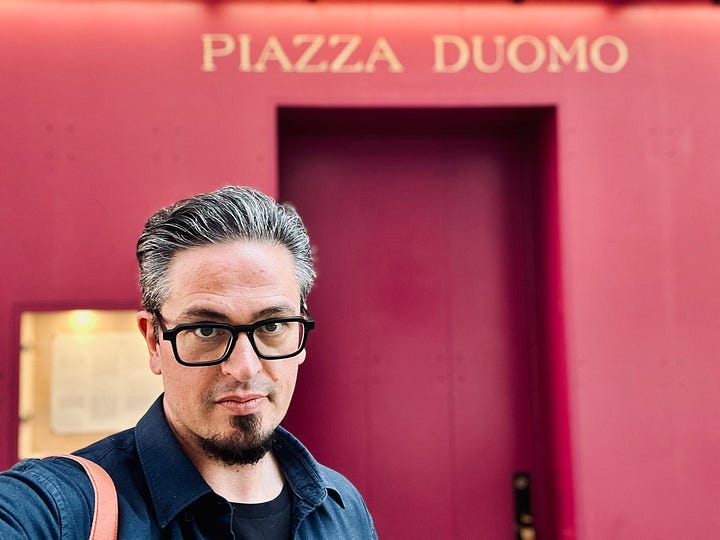

Piazza Duomo sits just off Alba’s main square. Step through its pink door, ascend a staircase, and you’re in a surreal space. The rounded ceiling and curved walls are frescoed by Francesco Clemente, a renowned Italian contemporary artist associated with the Transavanguardia movement.
As you open the menu you find out that it contains a small unique piece of art on canvas made by the same artist, which echoes some of the artwork you see on the walls, and it is yours to take home (they are all different and unique pieces).
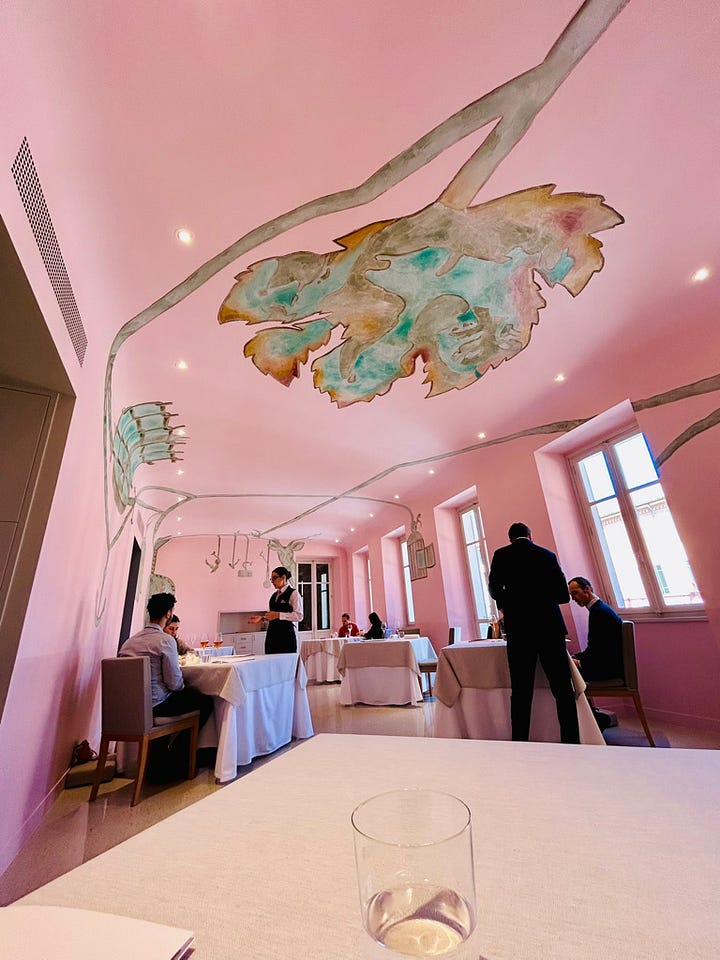
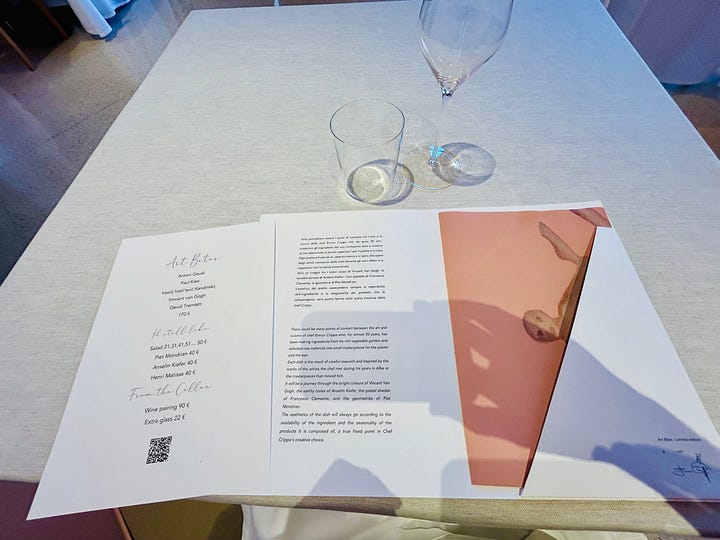
Benvenuto
The first two bites—Benvenuto—set the tone. Honestly, they were already worth the whole meal, not to mention some of the tastiest things I’ve ever had in my life.
Left side: foie gras cream, crispy corn, gingerino foam, and a peanut wafer. This was a feast for the taste buds—the richness of the foie gras was beautifully balanced by the bitterness of the gingerino (a drink that tastes a bit like a spritz!), with the crunchy corn in the middle adding texture. The peanut wafer was tasty, but honestly, I didn’t feel it was necessary.
Right side: a savoury krapfen filled with crème fraîche, topped with caviar, and served with warm fish broth. This was one of my favorite things ever—it was screaming umami from every particle. The fish broth, served on the side in a beautiful glass, coated your mouth with Mediterranean umami and perfectly prepared it for this bite: super light fried dough, rich crème fraîche (with something distinctly anchovy-like), and luscious caviar on top. I was completely sold—I nearly cried over this one.
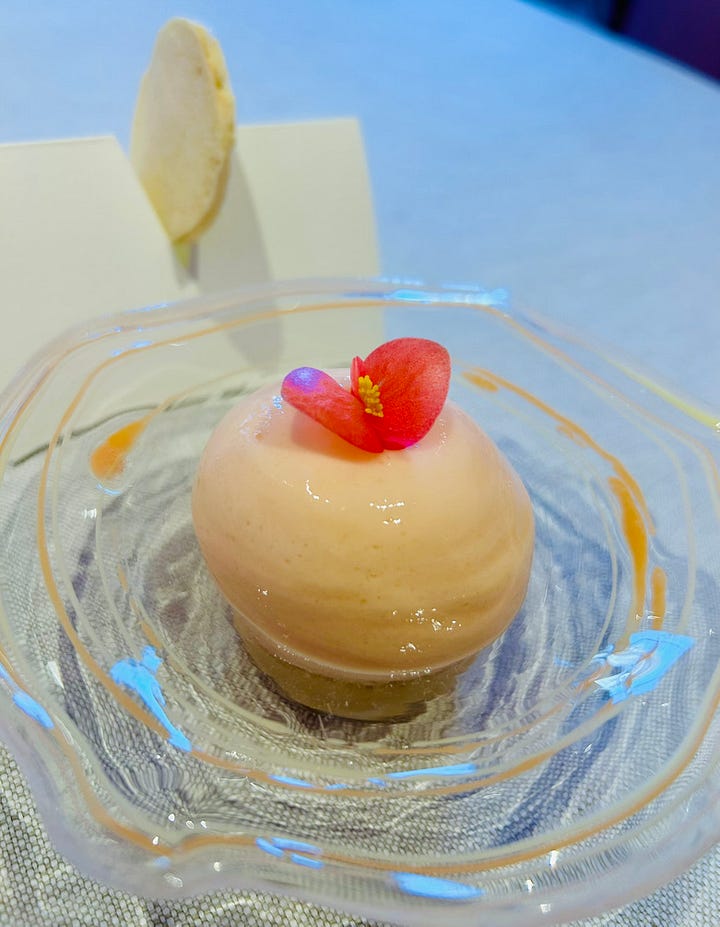
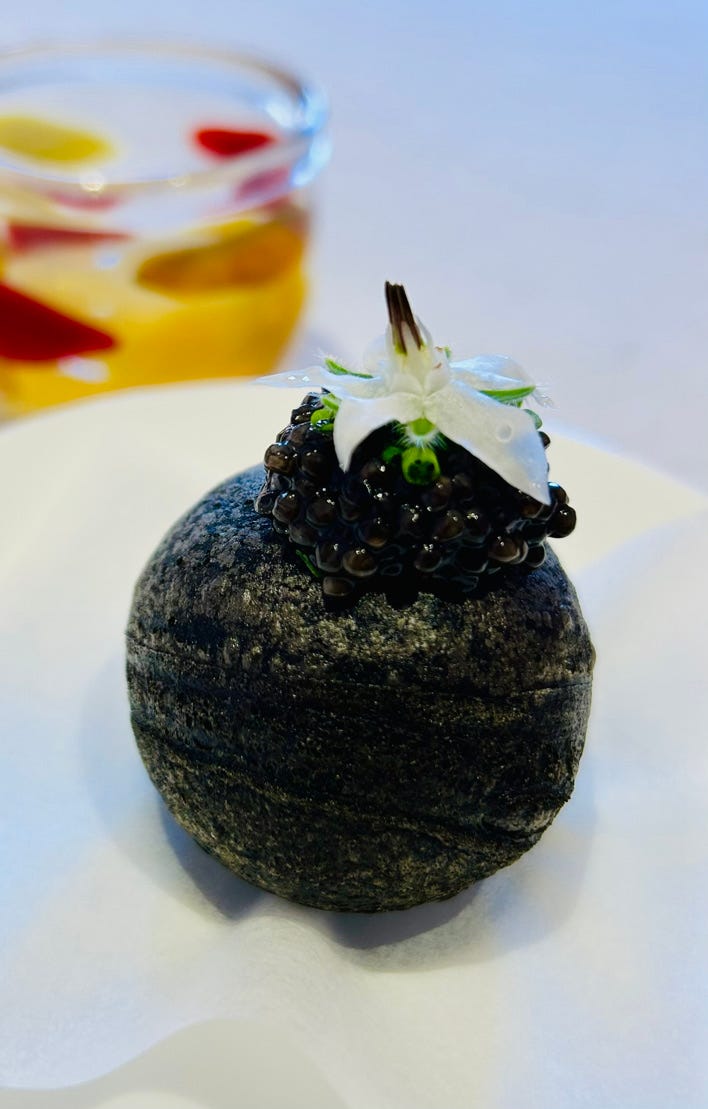
Almost immediately after that rich beginning, the table filled with tiny, vegetable-forward dishes—picked just that morning. They might have looked insubstantial, but each one was a flavor bomb and a celebration of spring. Special mention goes to the dish in the middle: a small piece of burrata and a scoop of peanut ice cream, covered in microgreens, edible flowers, broad beans, and pungent leaves.

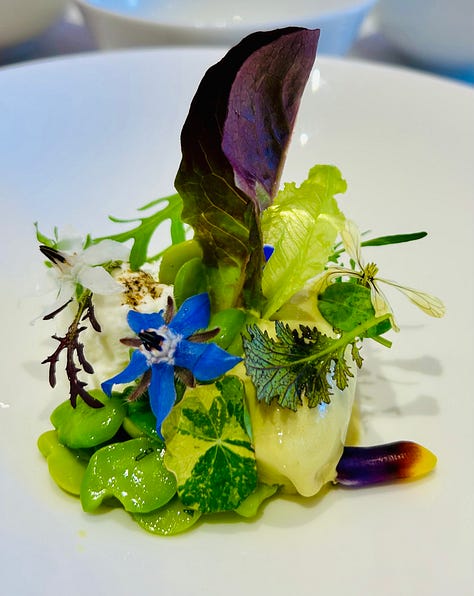
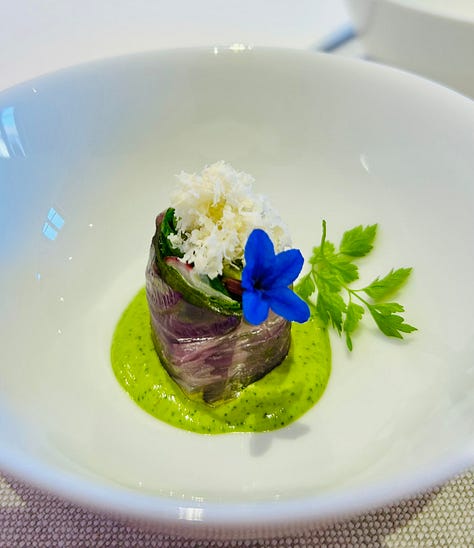
As you might know bread is always on the table in Italy, and here it arrived to stay after this intro. It featured that most incredible grissini (you might know they come from this area originally), some beautiful sourdough bread and and a muffin-shaped pastry studded with hazelnuts and sea salt (I dream about it to this day and wish I could have it for breakfast sometimes).

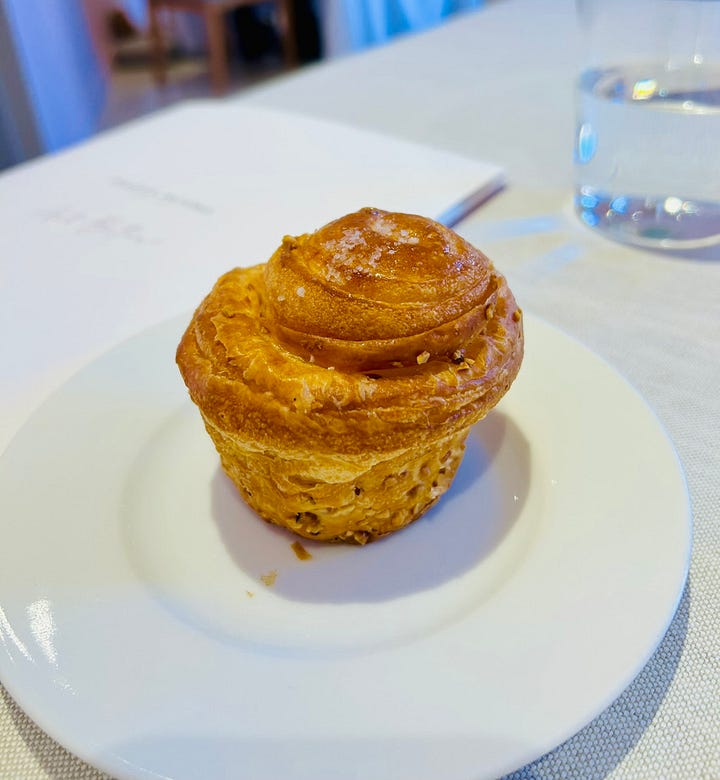
At this stage, I decided to have a single glass of wine. After a brief consultation with the sommelier, he recommended the Giarone Chardonnay, suggesting it could be a glass I’d enjoy sipping throughout the entire meal. I'm usually drawn to Piedmontese whites like Gavi and Arneis—wines known for their freshness, crispness, and acidity—so I was surprised by the complexity and structure of this one. It was full-bodied, with a notable alcohol content (up to 14.5%) and hints of wood and vanilla, yet it also retained a certain freshness that made it a well-balanced choice, especially alongside the richness of dishes like the risotto.
Gaudí on a Plate
The first “official” course: inspired by Antoni Gaudí. (the descriptions are from the menu).
Marinated egg yolk shaped like a star, filled with sauces inspired by the mosaics of Park Güell (parsley and fish, tomato choron, sea urchin sauce, bisque, bitter orange). On top, Ligurian prawns gently poached and seasoned with pancetta water and nori seaweed. On the side, an almond ice cream with sea urchin sauce, accompanied by a prawn broth.
The dish itself was incredibly rich. Each sauce had a distinct intensity, and together they blended into an infinite kaleidoscope of flavor, serving as a backdrop to the clean, delicate taste of the nearly raw prawns. What really stood out was the almond ice cream—it tasted like almond essence multiplied by three, and it married, in the most unexpected way, with the umami bomb of the sea urchin sauce. I’m still dreaming of that mouthful…
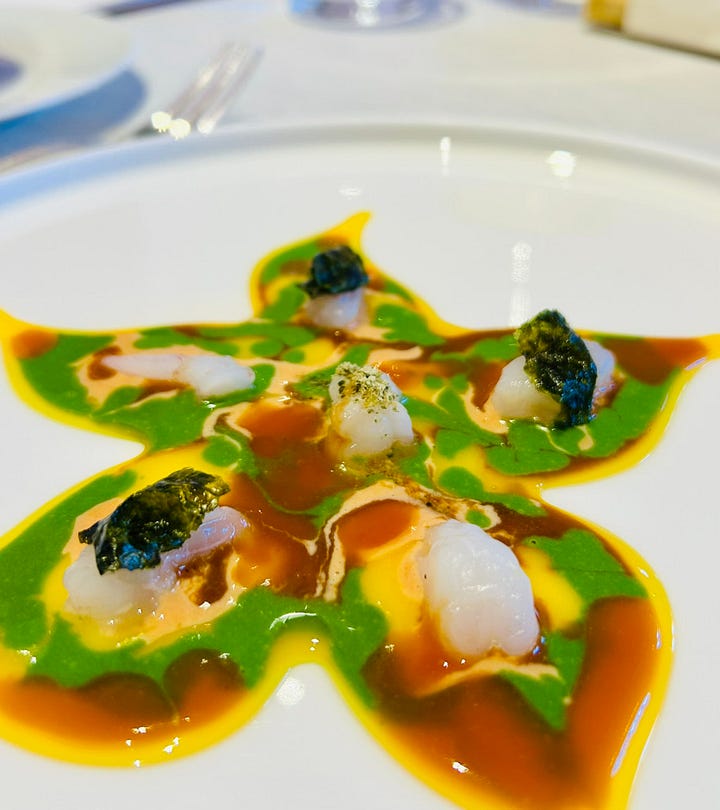
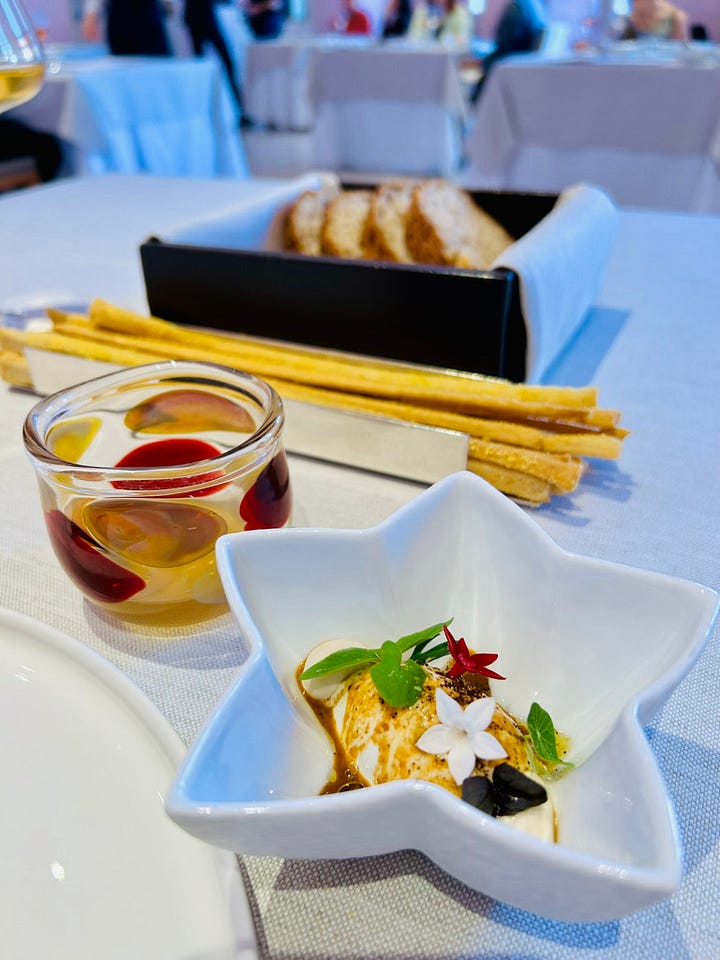
Klee’s Garden, in Risotto Form
Next: a risotto called Il Giardino delle Rose, inspired by Paul Klee.
Rice from the Ecorì consortium, creamed with violet butter and prepared using water from dried blue pea flowers. On top: violet vinegar, pea essence, and escabeche spices (coriander, cumin, charred lemon).
I’m not sure why, but it’s not mentioned that there were also a couple of delicious raw prawns (or perhaps gently steamed, like in the previous dish) placed on top. Visually, this risotto was striking—and it tasted just as good. Crippa comes from risotto land himself and it is no surprise that he is a master of the medium. Risotto has become so popular worldwide but I usually stay away from it as often it is as undercooked as it is underwhelming, and more than often turns it into a gloopy porridge. This one, however, was perfectly creamed all’onda and wonderfully light—cooked with water, not stock! Most of the flavor came from the butter, which was rich and deeply “dairy” (if that can be an adjective), and it paired beautifully with the sharp violet vinegar and spices. The prawns were a nice touch, but they felt a bit like an afterthought, and I’m not sure they added much to the overall flavor profile of the dish.
Kandinsky and Fassona
The secondo: an homage to Kandinsky.
The circles are foie gras sauce, veal jus with truffle, Marsala sauce, and parsley sauce. On top: Fassona beef fillet, omelette, cardoncelli mushrooms, and a Parmesan wafer with foie gras cream and pancetta.
Another visually stunning dish—which I suppose is essential for a menu inspired by visual arts. The meat was tender and succulent, with a pleasant charred flavor. The cardoncelli mushrooms nestled between the wafer and the meat added depth of flavor and introduced an intriguing textural contrast that made the dish playful on the palate. The sauces were rich and meaty, echoing some of the flavor notes from the appetizer course, but leaning more heavily into umami and meatiness. It was a delicious and satisfying dish, though the flavor profile felt a bit more predictable compared to the earlier surprises.
Van Gogh and Milk
Dessert was inspired by Vincent van Gogh and built on milk in all its textures:
Various milk textures. At the base: caramel cream (crème de mou), milk-cooked rice, milk cream, milk ice cream, and dehydrated milk colored with natural dyes (mint, licorice, roses, butterfly pea flowers, and chamomile).
At first, I wasn’t convinced. The freeze-dried milk looked beautiful but felt odd. But once I got the full vertical spoonful? I was hooked. The milk rice (riso al latte) tasted so incredibly good, especially with the richness of the caramel, and the icy dehydrated milk lightened and freshened up something that might have risked to be too intense. Maybe it was also a childhood memory of eating riso al latte (it was very common in my childhood), but this ended up being a favourite of this menu.
David Tremlett and the Epilogue
And then… post-dessert. Inspired by David Tremlett.
Wafers of raspberry, banana, hazelnut, cocoa, and matcha tea, served with raspberry cream, coconut, and matcha tea.
The wafers were crunchy, light, and surprisingly flavorful, offering a variety of interesting combinations with the creams in the small pot. Honestly, I was more excited by the little hazelnut cake (on the right), the delicious chocolate-covered Piedmont hazelnuts, the fresh strawberries, and the small glass bottle labeled Latte +, referencing A Clockwork Orange. (Thankfully, no ultraviolence—just a creamy zabaione with a hint of booze.)
This post-dessert course came with the option of ordering coffee or tea. Their coffee selection was genuinely impressive, and I couldn’t resist ordering a delicious—if very expensive—specialty espresso made with Panama Geisha beans. (Though I have to admit, I usually prefer these beans brewed as filter coffee rather than espresso.)
My thoughts
This was a fair amount of food. By the end, I wasn’t even able to finish some of the extra desserts and was given a small bag to take home with the leftover chocolates. If this was the “small” menu, I can hardly imagine how much food would be served with one of the regular ones!
Overall, this was an extraordinary meal—easily one of the most exciting culinary experiences of my life. I savored every bite of this limited-edition menu. In fact, I was especially moved by the simplicity and intense beauty of some of the small dishes at the beginning. While the main courses were all incredible, their architectural complexity was, for me, almost too much. But that probably says more about my personal taste—I love the intensity and purity of a single ingredient, just as I often prefer the beauty of a solo instrument to a meticulously produced track featuring 20. Crippa’s cuisine is masterful, executed at the highest level of technique. His attention to detail—both in the smaller plates and in the more ambitious ones—is striking. The almost Japanese minimalism in his flavor aesthetics and design speaks deeply to me.
The staff and service were outstanding, and I ended up having a long, engaging conversation with the restaurant director, Davide Franco. We talked about food, coffee, and the world of fine dining (this is one of the reasons I love going to these places alone—you learn so much more). The pacing of the meal was perfect; I barely had time to reflect between courses. Interestingly, there was no background music in the room—a detail I appreciated, as it allowed me to focus completely on the food. In fact, I often find the music in such restaurants to be the least considered element, often reduced to a random Spotify playlist.
One final touch I truly appreciated: after I had paid and was on my way out, the chef came out of the kitchen to greet me. We chatted for a few minutes, during which he graciously listened to my clumsy attempt to describe his work, and signed the unique artwork print that came with my menu.
I stepped back into the sunlight and wandered Alba’s center, dazed and delighted. A 3-star restaurant just a short drive from home. I still can’t quite believe it.
Time to start saving money…


If you enjoy my writing, please consider supporting it by subscribing to “Cooking by Ear”






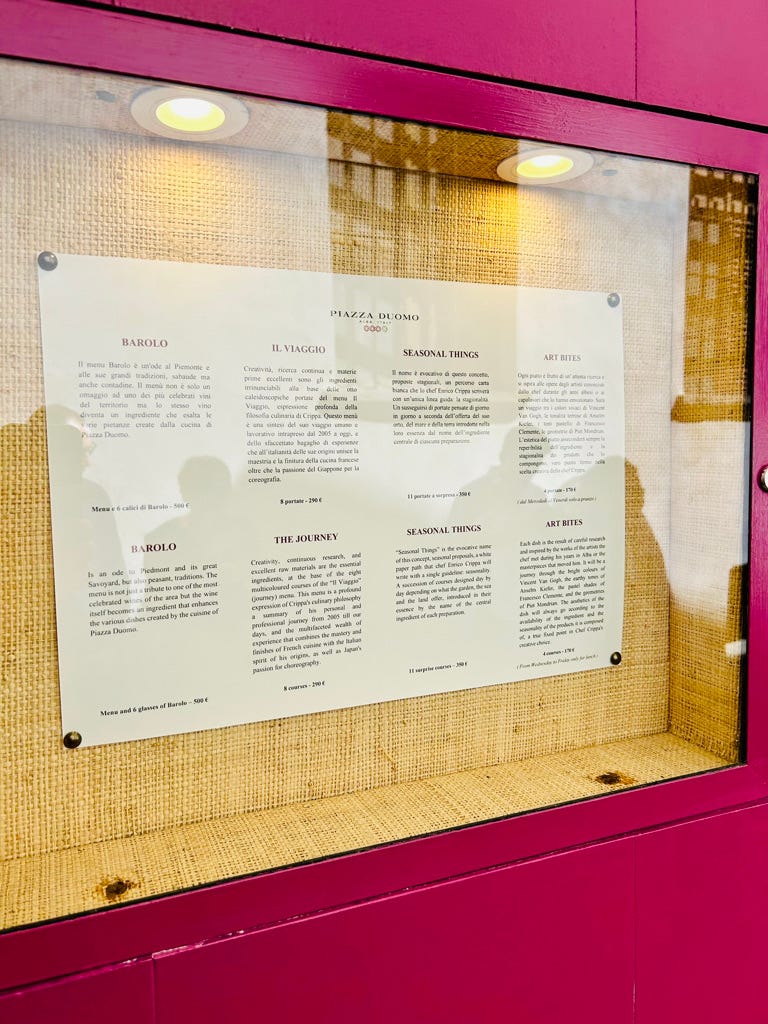
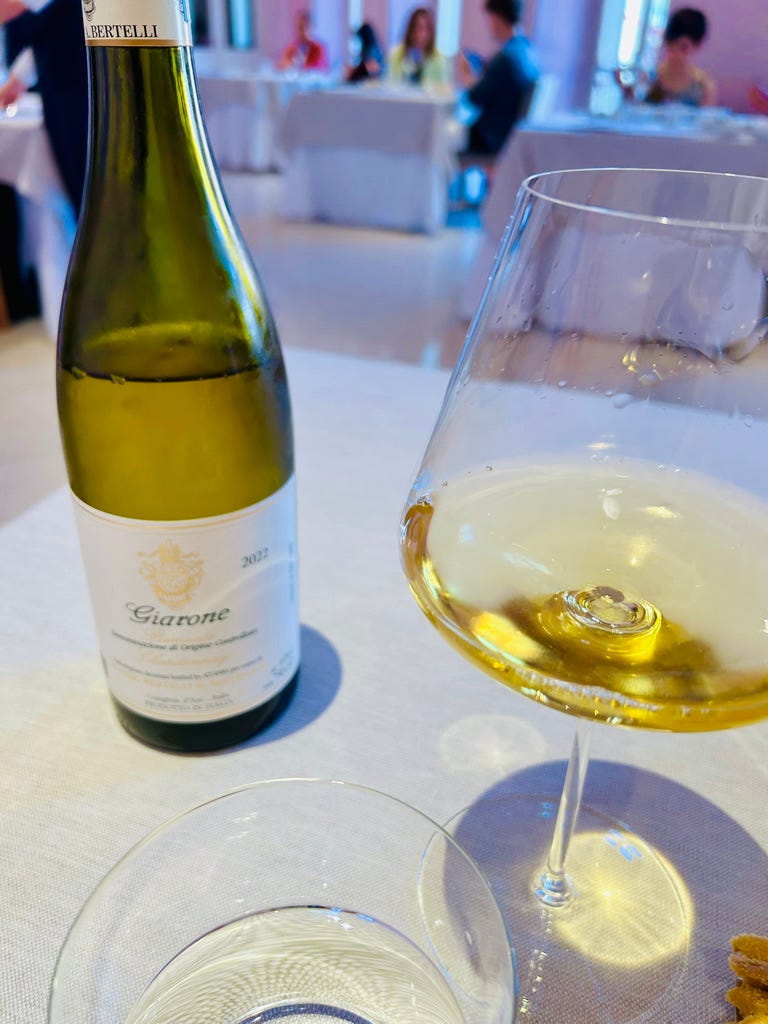
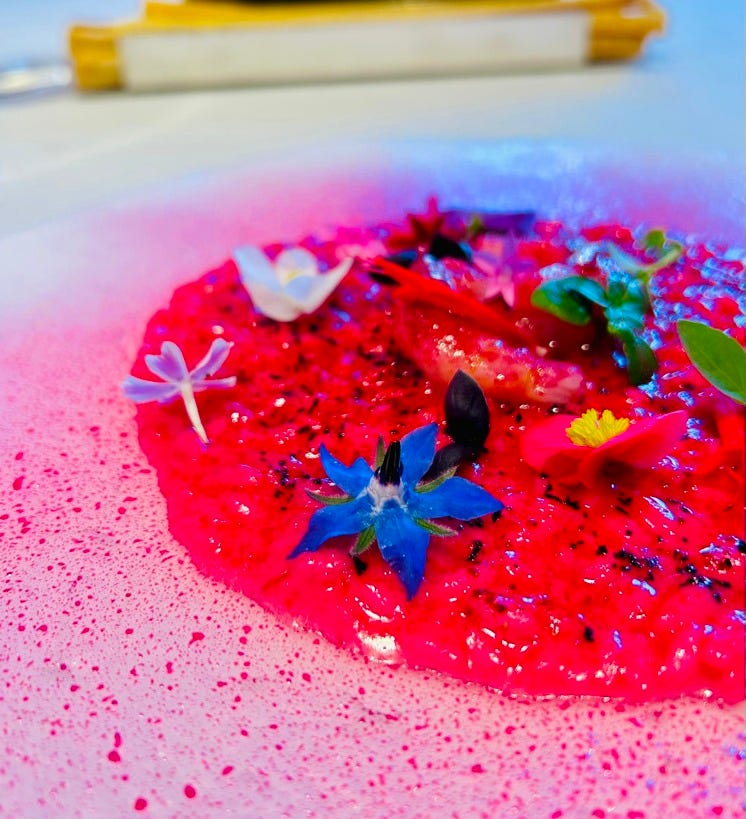
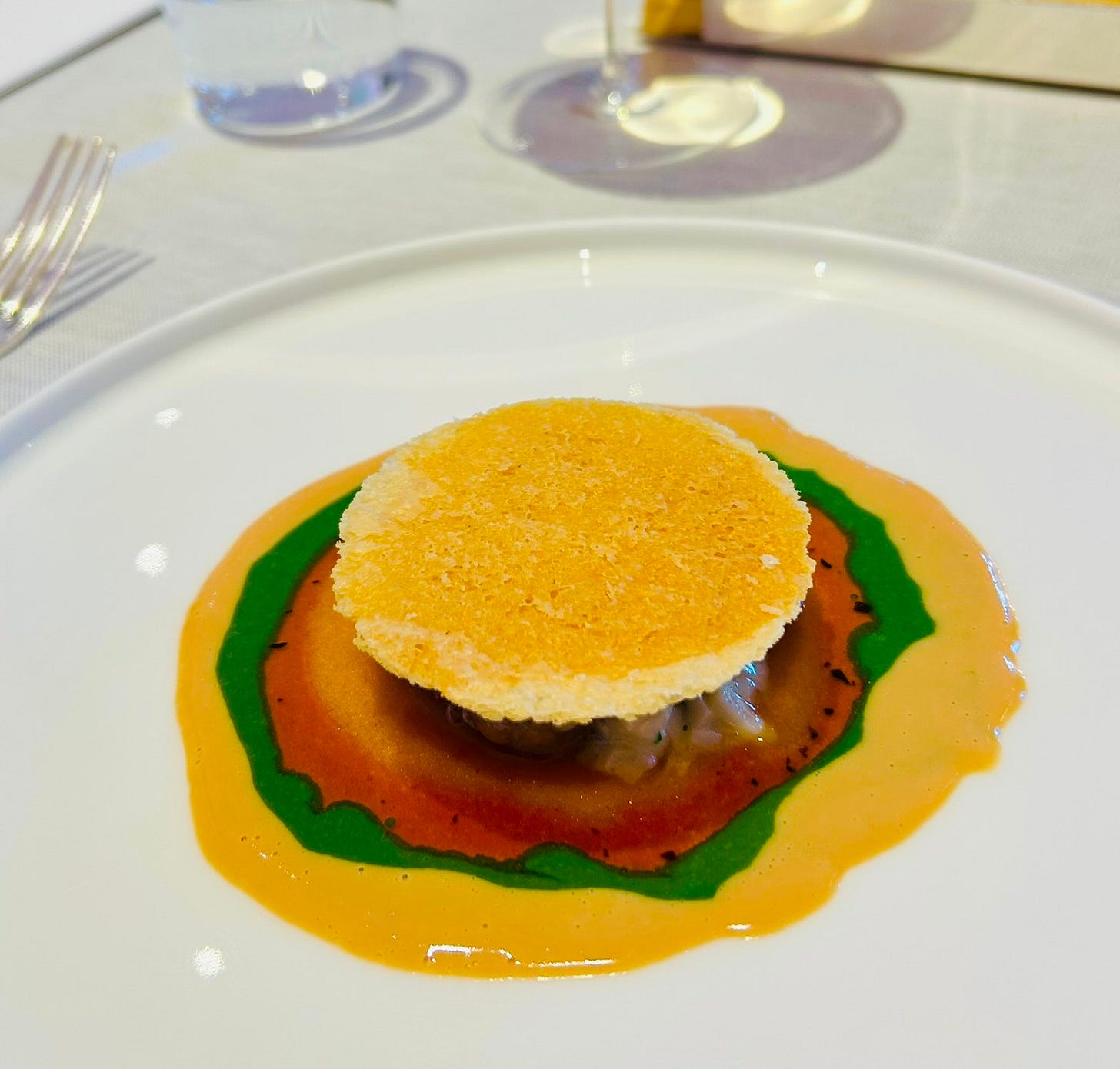


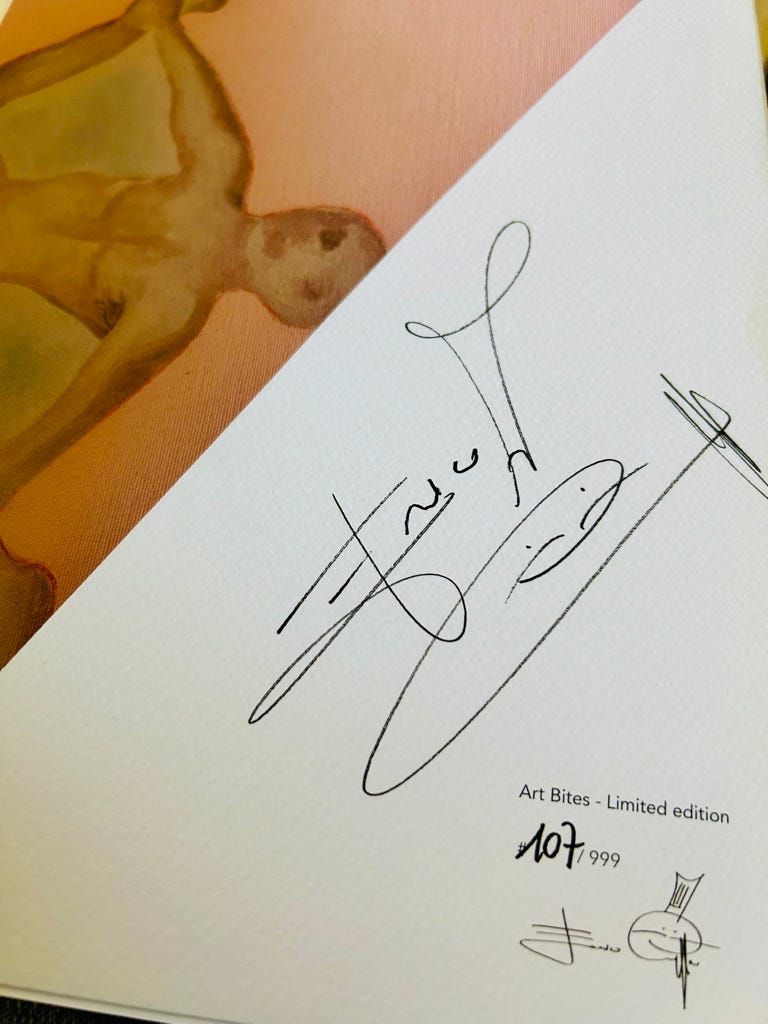
I agree with Bib Gourmand and Piazza Duomo1 Maybe you will like my latest post:
https://xtremefoodies.substack.com/p/the-perfect-meal?r=jt0nv
This will go down as one of their best Michelin reviews for sure!